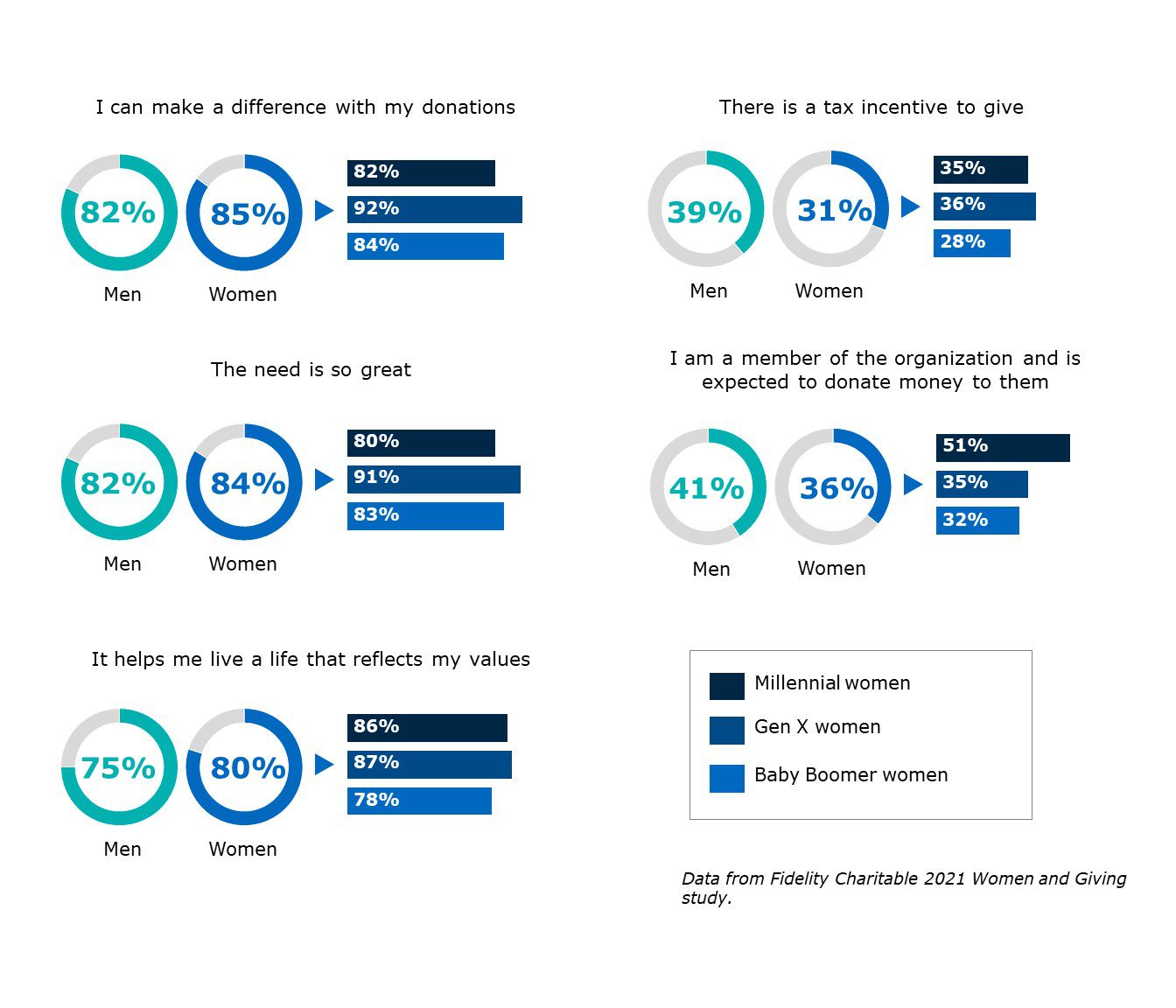The transformative impact of women in higher education philanthropy
In the evolving landscape of philanthropy, one trend stands out with remarkable clarity: the rising generosity and influence of women donors. As we move through the summer planning months and focus on strategies for FY25, the impact and opportunity of women’s giving on higher education is more significant than ever.
Understanding how women operate in philanthropy can change how institutions build and shape advancement priorities and strategies. In this blog, I’ll explore some trends and provide insights you should consider for your advancement program.
The Growing Force of Women Donors
Women’s participation in philanthropy has substantially increased over the past few years. With growing economic power and an expanding presence in leadership roles, women are stepping into the spotlight as major contributors to various causes, including education.
A study by EAB showed that women have greater wealth and longer life expectancies on average compared to men. As a result, women not only have more money in their own right but also stand to inherit additional wealth from their partners. Boston College’s Center on Wealth and Philanthropy estimates that women will inherit 70% of the expected $41 trillion intergenerational wealth transfer over the next few decades. This means advancement officers need to focus time and attention on cultivating and stewarding their top women donors.
Impact on Higher Education
Historically, women have supported scholarships, funded research, and fostered diversity and inclusion within institutions. Large gifts from women donors have funded initiatives in STEM education, supported first-generation college students, and advanced gender equity on many campuses.
These contributions do more than fill financial gaps; they set new priorities and push universities to innovate. Women donors often prioritize areas that align with their values, such as social justice, sustainability, and community engagement. This encourages institutions to broaden their focus and adopt more inclusive and forward-thinking agendas.
Motivations of Women Philanthropists
The Lily Family School of Philanthropy found that women tend to give to more organizations than men and are heavily incentivized by helping others.
According to a study by Fidelity Charitable, nearly nine in ten women want to do more to create positive social change. Their giving is based on empathy and a desire to help others, while men’s giving is more often driven by self-interest, such as tax benefits. For example, when a wife is the primary decision-maker in a couple’s charitable giving, the donations are more likely to be motivated by a spontaneous response to a need. Post-COVID-19, the study observed a shift, with men becoming more altruistic in their philanthropic support.
Engaging Different Generations of Women
Women donors often seek to be actively involved in the causes they support. Providing opportunities to participate in decision-making processes and take on leadership roles within the institution can significantly enhance their connection and commitment. However, studies show generational differences in how women give. Fidelity Charitable research indicates Millennial women are more likely to give in the moment from the heart and encourage others to give to the same organizations—think social media posts and tags. In contrast, Boomer women are more strategic regarding their philanthropic support, are happy with the organizations they choose to support, and rather than give on a whim, feel satisfied with their strategic plan for giving.
 What does this mean? We shouldn’t lump all women donors into strict segments of prospects or donors simply based on their gender. There are overarching similarities, such as being drawn to support social and healthcare causes. However, Millennials tend to favor supporting causes related to supporting women and girls, while Boomers are more likely to prioritize healthcare causes. The study also found that Millennials turn to crowdfunding or giving circles where they can pool money with other individuals to ensure their investment has a more significant impact. Boomers tend to favor sponsorships through events and gifts in kind.
What does this mean? We shouldn’t lump all women donors into strict segments of prospects or donors simply based on their gender. There are overarching similarities, such as being drawn to support social and healthcare causes. However, Millennials tend to favor supporting causes related to supporting women and girls, while Boomers are more likely to prioritize healthcare causes. The study also found that Millennials turn to crowdfunding or giving circles where they can pool money with other individuals to ensure their investment has a more significant impact. Boomers tend to favor sponsorships through events and gifts in kind.
Women and Giving Circles
Research shows roughly 70% of giving circles are comprised of women. According to a study by the Lily Family School of Philanthropy, the top three causes that women-dominant giving circles support are human services, women and girls, and education.
Examples of Giving Circles in Action
Duke University
Duke Women’s Impact Network began in 2012. I was part of the initial programming targeted to speak to the values held important for women at Duke – staff, faculty, students, parents, friends, and supporters. Today, the yearly programming has evolved into a vibrant philanthropic community.
Dartmouth College
Dartmouth’s Centennial Circle celebrated its 10th anniversary in 2024. During its existence, “The Centennial Circle has 335 members who together have given more than $100 million for financial aid, funding the equivalent of 1,768 full scholarships.”
Oregon State University
At Oregon State University, a giving circle for women was created featuring tiered membership levels. The circle engages individuals via digital channels and encourages participation through the ability to review and vote on submissions of proposals to support university projects. Those who donate can work with other donors when choosing how their dollars will impact OSU. The university also uses individual involvement to engage and cultivate board members and grow relationships for future philanthropic opportunities.
The question begs to be asked, with the success of these giving circles in higher education, why hasn’t there been a more focused effort to work with women to ensure they feel included and valued as our philanthropic partners?
The Future of Women Giving
As we look to the future, the impact of women’s philanthropy is poised to grow even more significant. Predictions for 2025 and beyond indicate that women will play an increasingly prominent role in shaping the priorities and directions of higher education. This shift will likely lead to a more inclusive and diverse educational landscape, with long-term benefits for institutions and society.
Despite the growing influence of women donors, challenges remain. Historical biases in fundraising and donor recognition need to be addressed to create a more inclusive environment. Institutions must innovate to reach and engage women donors effectively. Collaborative efforts between institutions and women-led organizations can also play a crucial role in expanding the reach and impact of women’s giving. These partnerships can foster a supportive network that amplifies the contributions of women donors and promotes shared goals.
Conclusion
The importance of giving by women cannot be overstated. Their contributions drive change in higher education, foster innovation, and promote inclusivity. As institutions adapt to their growing influence, they will be better positioned to meet the challenges of the future and create a lasting impact on students, faculty, and communities. By recognizing and supporting the unique strengths of women donors, higher education can continue to thrive and evolve in meaningful ways.
Ready to learn more?
Request to speak with an EAB expert about your advancement marketing strategy.

More Blogs

How affluent women are redefining philanthropy

Four advancement predictions for 2026
